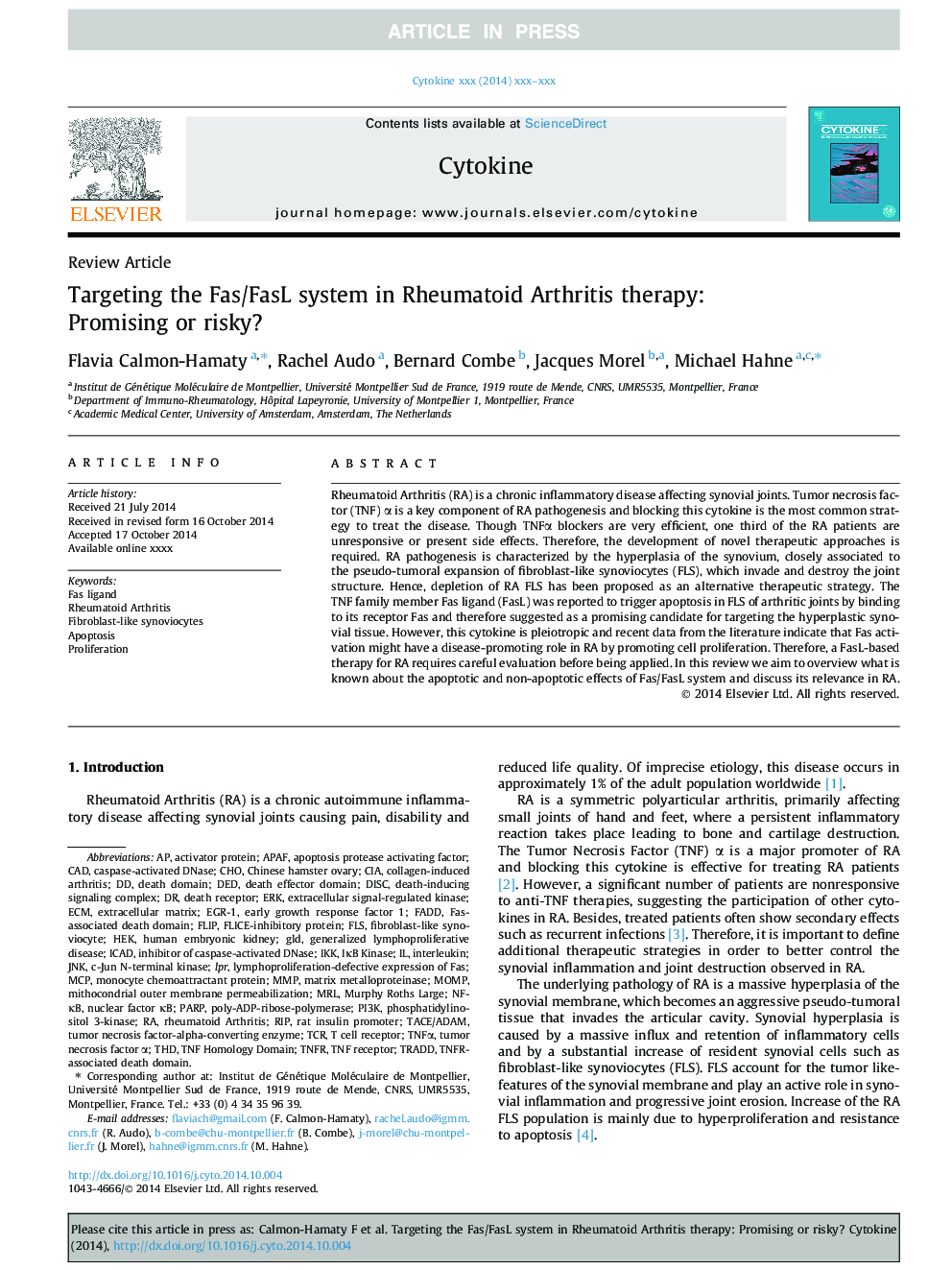| کد مقاله | کد نشریه | سال انتشار | مقاله انگلیسی | نسخه تمام متن |
|---|---|---|---|---|
| 5896924 | 1155246 | 2015 | 6 صفحه PDF | دانلود رایگان |
عنوان انگلیسی مقاله ISI
Targeting the Fas/FasL system in Rheumatoid Arthritis therapy: Promising or risky?
دانلود مقاله + سفارش ترجمه
دانلود مقاله ISI انگلیسی
رایگان برای ایرانیان
کلمات کلیدی
ICADTCrERKFLSMRLIKKECMFADDEGR-1PARPGLDDISCFLIPDEDTNFRTRADDTHDAPAFPoly-ADP-ribose-polymeraseinhibitor of caspase-activated DNaseFLICE-inhibitory proteinHEKJnkTNFαNF-κBPI3KMCPMMPLPRc-Jun N-terminal kinase - C-Jun N-terminal kinaseIκB kinase - IkB kinasecollagen-induced arthritis - آرتروز ناشی از کلاژنRheumatoid arthritis - آرتریتروماتوئیدinterleukin - اینترلوکینCho - برایChinese Hamster Ovary - تخمدان هامستر چینیProliferation - ترویجtumor necrosis factor α - تومور نکروز عامل αdeath domain - حوزه مرگFas-associated death domain - حوزه مرگ مرتبط FasApoptosis - خزان یاختهایdeath effector domain - دامنه موثر مرگCIA - سیاCAD - طراحی به کمک رایانه یا کَدFas Ligand - فاس لیگاندearly growth response factor 1 - فاکتور رشد اولیه رشد 1nuclear factor κB - فاکتور هسته ای κBPhosphatidylinositol 3-kinase - فسفاتیدیلینواستیل 3-کینازExtracellular matrix - ماتریکس خارج سلولیmatrix metalloproteinase - ماتریکس متالوپروتئینازMOMP - ماموریتfibroblast-like synoviocyte - مانند سینوویوسیت فیبروبلاستfibroblast-like synoviocytes - مانند سینوویوسیت های فیبروبلاستRIP - پاره کردنmonocyte chemoattractant protein - پروتئین شیمیایی monocyte chemoattractantactivator protein - پروتئین فعال کنندهrat insulin promoter - پروموتر انسولین موشdeath-inducing signaling complex - پیچیدگی سیگنالینگ ناشی از مرگcaspase-activated DNase - کاسپاز فعال DNasehuman embryonic kidney - کلیه جنین انسانextracellular signal-regulated kinase - کیناز تنظیم شده سیگنال خارج سلولیTNF receptor - گیرنده TNFT cell receptor - گیرنده سلول Tdeath receptor - گیرنده مرگ
موضوعات مرتبط
علوم زیستی و بیوفناوری
بیوشیمی، ژنتیک و زیست شناسی مولکولی
علوم غدد
پیش نمایش صفحه اول مقاله

چکیده انگلیسی
Rheumatoid Arthritis (RA) is a chronic inflammatory disease affecting synovial joints. Tumor necrosis factor (TNF) α is a key component of RA pathogenesis and blocking this cytokine is the most common strategy to treat the disease. Though TNFα blockers are very efficient, one third of the RA patients are unresponsive or present side effects. Therefore, the development of novel therapeutic approaches is required. RA pathogenesis is characterized by the hyperplasia of the synovium, closely associated to the pseudo-tumoral expansion of fibroblast-like synoviocytes (FLS), which invade and destroy the joint structure. Hence, depletion of RA FLS has been proposed as an alternative therapeutic strategy. The TNF family member Fas ligand (FasL) was reported to trigger apoptosis in FLS of arthritic joints by binding to its receptor Fas and therefore suggested as a promising candidate for targeting the hyperplastic synovial tissue. However, this cytokine is pleiotropic and recent data from the literature indicate that Fas activation might have a disease-promoting role in RA by promoting cell proliferation. Therefore, a FasL-based therapy for RA requires careful evaluation before being applied. In this review we aim to overview what is known about the apoptotic and non-apoptotic effects of Fas/FasL system and discuss its relevance in RA.
ناشر
Database: Elsevier - ScienceDirect (ساینس دایرکت)
Journal: Cytokine - Volume 75, Issue 2, October 2015, Pages 228-233
Journal: Cytokine - Volume 75, Issue 2, October 2015, Pages 228-233
نویسندگان
Flavia Calmon-Hamaty, Rachel Audo, Bernard Combe, Jacques Morel, Michael Hahne,